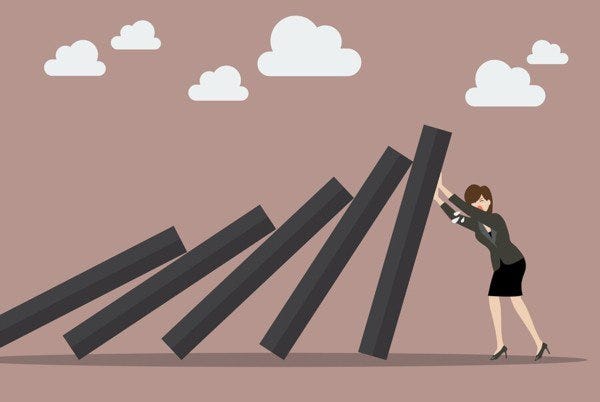Among the great movies of the 1980s is The Natural. The movie starred Robert Redford as the baseball player Roy Hobbs. It is based on the book by Bernard Malamud.
I loved the movie as a kid because of all the home run scenes. But I love it as an adult because of what it says about life and the human condition.
The turning point of the movie is when Roy Hobbs is shot. He is on his way to the major leagues. Then he meets a woman on the train. She shoots him in the stomach. His career is shattered.
We never learn why the woman shot Hobbs. She was not a spurned lover. She had no financial motives. She just shoots him. There is no rhyme or reason.
No One Knows
Life is like that sometimes. We suffer a tragedy for no apparent reason.
Some theologians suggest God always has a reason for what happens to us, even if we cannot discern it. That theology works for some people.
But it can also feel incomplete, even hurtful and destructive, when we are suffering. It's like getting a slap in the face when we need a hug.
But regardless of what we believe caused the suffering, we need resilience.
What is it? How do we build it? The simplest definition is the ability to cope with life's hardships. Those hardships vary in degree. But we all face them.
Acknowledgment
The first step is an acknowledgment of the pain. In Jewish tradition, when we learn of the death of an immediate family member, the first thing we are supposed to do is tear our outer garment.
It is an immediate unequivocal acknowledgement of our loss. There is no denial. There is utter clarity.
Now acknowledgment is not the same thing as acceptance. Acknowledgment is affirming the hardship is real. Acceptance suggests being at peace with it.
Acceptance cannot happen without acknowledgment, but acknowledgment can happen without acceptance.
Moving from acknowledgment to acceptance is usually a function of time. But we can move it along in a few ways.
Acceptance
The first is a coping ritual. These include daily practice like journaling, prayer, and talking with friends. They put us on the road to acceptance.
In traditional Judaism, that coping ritual is saying the kaddish prayer. For eleven months, someone who has lost an immediate family member says the kaddish prayer daily.
Other coping rituals work. I could spend days telling you stories about people in my community who have used ancient rituals and created their own to cope with hardships.
The key is to do them with an attitude of gratitude. I know this sounds like a cliche. It also sounds paradoxical. How can we be grateful for experiencing hardship?
The key is knowing we are not expressing gratitude for the hardship. Rather, we are grateful for having the ability to cope with it.
We are telling ourselves we are resilient by engaging in a coping ritual. We are embodying resilience even when we are not yet certain we have it!
The Body Before the Mind
This technique works because resilience begins with our body. We need to do something. The body shapes the mind.
Fascinating research has shown the body often feels something before the mind comprehends it. We can bring our body toward resilience so that our mind ultimately feels it.
That's where real acceptance happens. It is not automatic. It has to feel true. We have to realize we are capable of acceptance.
Now the key here is timing. If we try to tell ourselves to be resilient right after we experience hardship, it might feel inauthentic. Acknowledgment of hardship has to precede acknowledgment of resilience.
Growth
The final stage of resilience is growth. Now sometimes this doesn't happen. And it is not always necessary to cope.
But anyone who has lived long enough knows we grow more through hardship than we do through triumph.
What leads to growth? And how do we know we've had it?
The great Jewish sage Maimonides defined growth in the context of overcoming sin when he said a redeemed person faces the same temptation and then refrains from repeating the sin.
If a sin caused real hardship for someone, Maimonides insight is a good guide for defining growth.
Look for the Beautiful
One other way to foster growth is to look for the beautiful. It is to direct our attention to what is positive, life-giving, surprising, inspiring.
Prayer may be the oldest way we have of looking for the beautiful.
In Judaism, as I mentioned earlier, we say the kaddish prayer daily after experiencing a loss. But the kaddish is only said as part of a regular prayer service.
And most of the other Jewish prayers describe and give thanks for the beauty and wisdom of God's creation.
In other words, prayer opens us up to the beautiful. It generates positive emotions.
Over time those positive emotions nurture our resilience muscle. We see ourselves as part of something bigger than ourselves. We look at what we have experienced from a different perspective. That is growth.
God’s Faith in Us
What we do with that new perspective is up to us. Here is where faith is compelling. God has faith in us. God has faith we can live with beauty, purpose, and meaning. We can write a new story.
A friend of mine once compared God's role in resilience to the moving walkways we see in airports. God is helping us to keep moving.
Even we when slow down, God keeps us moving. And as we speed up, God stays with us and delivers us to the next stage of life.





As always, I am inspired and grateful for your wisdom and insights. Thank you.